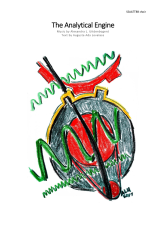Here are the cover and programme notes for my choral work from last year.

Aftermath explores aspects of the aftermath of sexual assault, from the personal to the official in a variety of musical styles in six movements.
Naiveté Stripped is about fear related to an incident that has just occurred, and isn’t fully realised. Musically it is influenced by Portishead. The choral arrangement explores the space between the use of the flexibility of vocal timbre as substitute instrument and writing specifically for voices.
Desiring Invisibility explores the use of modulation with modes, and uses natural word rhythms.
Realising Vulnerability builds up a sentence phrase by phrase, and incorporates strategically placed finger snaps as interruptions.
Echoes of Fear is about fear related to something that happened in the past. It builds up repeated layers as might happen with a looper, and emphasises the recurring themes in the mind, in a similar way to the line of text that states “Things go round and round in my head like the sounds a looper’s fed”.
World Cloud is a prototype data sonification of texts related to sexual assault, taking its name from “Word Cloud”, a representation of text by frequent words that characterise the text, shown in a cluster with different font sizes for different frequency levels. For each section, the top 30 word frequencies were determined for a specific set of texts and converted to audio frequencies for the vocal range of bass low G to soprano high F#. Each vocal part is allocated an unoverlapping range of a minor sixth, and words are performed in frequency order, with each range sung simultaneously, and parts starting in order of first appearance in the text. Durations are a minimum of a quaver (usually the bass part), and other parts are scaled to approximately match the duration of the word list. The first text is a collection of resources on sexual assault. The second is a set of letters, all but one of which were downloaded from an internet search for “letter to my rapist”. (Rape survivors are often encouraged to write a letter to their rapist as part of their process of recovery.) The third section consists of Australian legal text related to sexual assault. The fourth takes all texts together. The coda just takes the most frequent six words across the entire text corpus. The vocal parts are supported by starting notes commencing each section, played by flute, clarinet and piano. Additional notes at strategic locations occur at starts of bars.
Hope is about overcoming fear and regaining power. The text is inspired by the victim statement from the People v. Turner case publicised on Buzzfeed.
Movements 1, 4 and 6 of Aftermath were originally performed as a unit of songs in popular styles under the title Songs of Fear at the RMIT Occasional Choral Society Occasional Choral Competition Concert 2016. Aftermath was originally performed as movements 2, 3 and 5 at the same concert.
The final movement, Hope, I make available for free download, with the intention that it be sung in support of victims of sexual assault, and also in solidarity with others who are marginalised, such as those from minority genders and sexual orientations.


